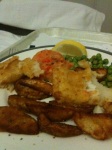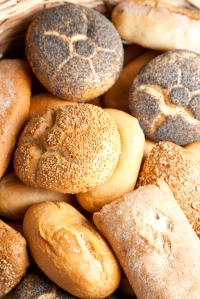Many years ago I was a strict vegetarian and still do prefer a vegetable based diet. Camping in remote areas and travelling through fruit fly checks meant that it was difficult to have a good supply of vegetables and fruit. Dehydrated meals, apart from the extra water needed, are for the whole pretty bland and disgusting.
Often I will request a vegetarian meal at a function, not because I’m being contrary, but because I’m just not eating meat at the time. Invariably disappointment follows. Surely most chefs have some imagination and understand the key part of the word “vegetarian”.
Some of the most unimaginative vegetarian meals I have received are as follows:
A square of commercial puff pastry that contained still partially frozen mixed vegetables – peas, corn and carrots at a venue in bayside Melbourne that was noted for fine dining.
 Fish and chips! Yes, this was served up as a “vegetarian meal” in the cardiac ward of a private hospital.
Fish and chips! Yes, this was served up as a “vegetarian meal” in the cardiac ward of a private hospital.
Of course! Potatoes, peas and carrots are vegetables.
The replacement meal when I asked for vegetables (and I don’t think I was bei ng difficult) was a handful of mixed salad leaves and some grated carrot. The kitchen staff kindly offered to add some chicken for flavour!
ng difficult) was a handful of mixed salad leaves and some grated carrot. The kitchen staff kindly offered to add some chicken for flavour!
Breakfast the next morning was inedible. Fruit that had begun the decaying process long before it was placed on the plate and served up.
But I digress….
Recently I have been to a couple of functions. On booking for both, I specified vegetarian. Lunch was served and the usual alternate plates of red meat/white meat were offered. The vegetarian option when it eventually arrived was a pumpkin risotto… sigh….. this has happened before…… load the plate up with gluggy rice, mash some pumpkin through and chuck some Parmesan cheese on top. I do concede that rice is a grain, but not a whole grain.
Next event was an evening meal. Entree was a tomato and basil soup. Not bad! Main course for the rest was a glutinous mound of shiny mashed potato and a beef stew, purporting to be goulash. My vegetarian plate came out and you could smell the garlic at three paces….. oh dear! A large bowl of penne, with a drizzle of tomato paste and liberally mixed with chopped garlic. There wasn’t anyway to scrape it off… it was if the chef had accidently slipped and tipped about a half a jar of minced garlic into the bowl… it was on the penne, in the penne … everywhere… and seriously inedible. I wish I had taken a photo of it.
The organizer had noticed I wasn’t eating and enquired…. she came over to inspect the plate and agreed that she wouldn’t be able to eat the meal either. A replacement meal was organized and credit where credit is due… was delicious. The chef had used some imagination and gone wild with the vegetables!
Tofu, stirfried broccoli, carrots, onions and a spicy sauce over Hokkien noodles and topped with crispy onion bits. I did have a bit of a chuckle when the wait staff asked as I was leaving, if the dish wasn’t too spicy for me…… they weren’t to know that I eat lots of very hot chilli!!
Vegetarian meals in mainstream restaurants don’t have to be boring or difficult….or even an overload of carbs…… A seasonal warm winter dish of roasted vegetables….. potatoes, pumpkin, beetroot, carrot served with a cauliflower “rice. Stirfries with a mix of seasonal vegetables and a touch of tofu. Salads with a variety of leaves and other vegetables, seasoned with herb dressings.
Randolph Stone in his book Health Building revised some 30 years ago writes, “First things first even in health building: understanding and purpose are the blueprints of our life, the body is our garden and house which we must care for if we want to live in it. So we select the right food (fuel) which we can easily digest and which has all the finer natural elements in its uncooked state for replacing worn out elements and tissues. ….. Good digestion produces good oxydation and elimination. …. ”



